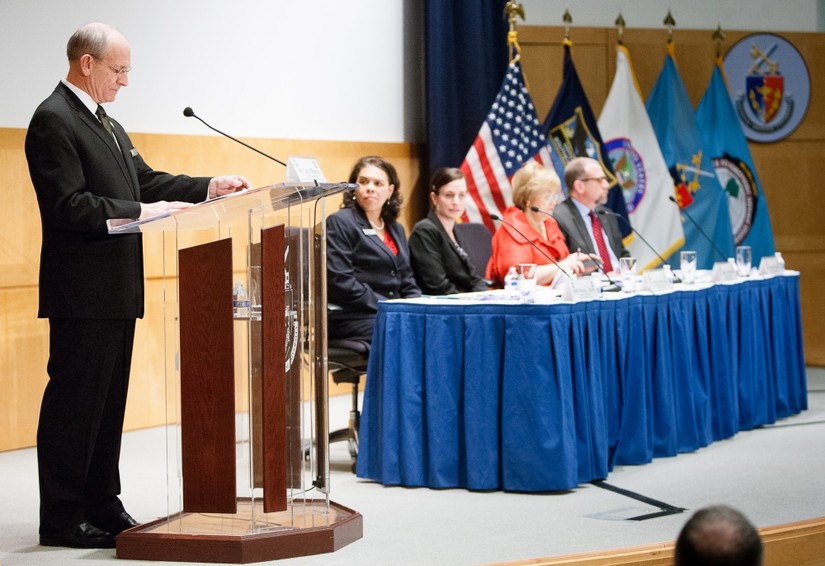The Defense Department fully supports the whole-of-government implementation of the Women, Peace and Security Act through the U.S. Strategy on Women, Peace and Security and the supporting plans, and views this initiative as essential for U.S. national security, a senior staff member said on Capitol Hill.
In her prepared remarks, Stephanie Hammond, acting deputy assistant secretary of defense for stability and humanitarian affairs, gave an overview of how the Defense Department is implementing the Women, Peace, and Security Act and Strategy at a July 23 hearing of the House Oversight and Reform Committee’s national security subcommittee. The hearing focused on the implementation of the U.S. Strategy on Women, Peace and Security.
”As our adversaries and competitors continue to seek a strategic advantage, the United States and our partners must be better prepared to meet security challenges by recognizing the diverse roles women play in conflicts, and by incorporating their perspectives throughout our plans and operations,” Hammond said. ”Advancing the U.S. Strategy on Women, Peace and Security provides a unique engagement opportunity to strengthen relationships with U.S. allies and partners through collective efforts to reinforce women’s empowerment, meaningful participation in decision-making, protection from violence and access to resources.”
Hammond told the subcommittee that last month, in accordance with the Women, Peace and Security Act of 2017 and the U.S. Strategy on Women, Peace and Security, the Defense Department and its interagency partners launched its Women, Peace and Security Strategic Framework and Implementation Plan. DOD’s implementation of the Women, Peace and Security agenda highlights and builds upon best practices that strengthen our armed forces and further our national security objectives.”Stephanie Hammond, acting deputy assistant secretary of defense for stability and humanitarian affairs
”This document is the first departmentwide implementation plan that outlines how the department will support the intent of the U.S. Strategy on Women, Peace and Security through attention to the composition of our personnel and the development of our policies, plans, doctrine, training, education, operations and exercises,” she said.
This approach will support the National Defense Strategy, Hammond said, and increase the Defense Department’s operational effectiveness.
The plan details three overarching defense objectives, she noted, to orient DOD’s implementation of the U.S. Strategy on Women, Peace and Security. The three objectives are:
- Defense Objective No. 1: DOD exemplifies a diverse organization that allows for women’s meaningful participation across the development, management and employment of the joint force.
- Defense Objective No. 2: Women in partner nations meaningfully participate and serve at all ranks and in all occupations in the defense and security sectors.
- Defense Objective No. 3: Partner-nation defense and security sectors ensure women and girls are safe and secure, and that their human rights are protected, especially during conflict and crisis.
”DOD’s implementation of the Women, Peace and Security agenda highlights and builds upon best practices that strengthen our armed forces and further our national security objectives,” Hammond said. ”Since the enactment of the WPS Act of 2017 and the approval of the U.S. Strategy on WPS, the department has significantly increased its WPS activities, with generous support of funding from Congress.”
Hammond noted that the department has implemented WPS by building an active network of subject matter experts at combatant commands, as well as the Joint Staff and the Office of the Secretary of Defense. These personnel advise commanders and staffs on how to integrate gender perspectives into operations, and engage with partner nations on women, peace, and security through activities such as conferences, training events, standard operating procedure development, and emphasis on WPS principles in military operations and multilateral exercises such as Flintlock, Khaan Quest, Gema Bhakti, and Pacific Sentry.
The department has engaged more than 50 partner nations to demonstrate the value of women’s meaningful participation, empowerment and safety to national security, and to share best practices on the recruitment, employment, development, retention, and promotion of women in military forces.
For example, Hammond told the House panel, U.S. Africa Command has worked with the Nigerien armed forces to adapt their recruitment methods to increase the number of women in their ranks and to promote women into leadership positions, U.S. Indo-Pacific Command has engaged with a local organization in Mongolia to work with women in rural areas to build their resilience capacity and leadership skills in disaster response and relief efforts, she said.
”With the launch of the department’s Women, Peace and Security Strategic Framework and Implementation Plan, DOD will further institutionalize and expand on the critical WPS work across components, and continue to coordinate closely with and support our interagency partners on this initiative to make the United States safer and more secure,” Hammond said.






